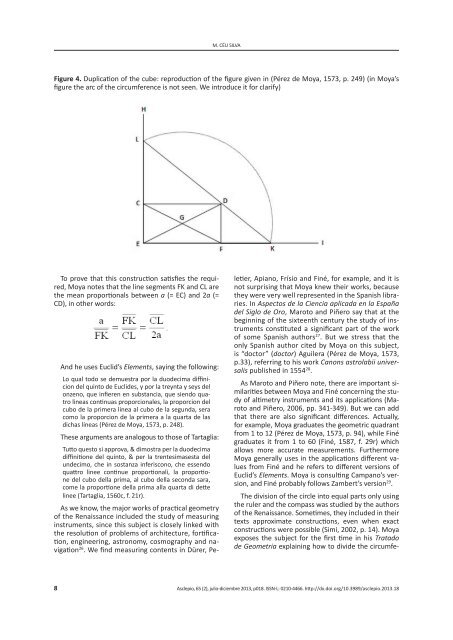RENAISSANCE SOURCES OF JUAN PÉREZ DE MOYA’S GEOMETRIES
Create successful ePaper yourself
Turn your PDF publications into a flip-book with our unique Google optimized e-Paper software.
M. CÉU SILVA<br />
Figure 4. Duplication of the cube: reproduction of the figure given in (Pérez de Moya, 1573, p. 249) (in Moya’s<br />
figure the arc of the circumference is not seen. We introduce it for clarify)<br />
To prove that this construction satisfies the required,<br />
Moya notes that the line segments FK and CL are<br />
the mean proportionals between a (= EC) and 2a (=<br />
CD), in other words:<br />
And he uses Euclid’s Elements, saying the following:<br />
Lo qual todo se demuestra por la duodecima diffinicion<br />
del quinto de Euclides, y por la treynta y seys del<br />
onzeno, que infieren en substancia, que siendo quatro<br />
lineas continuas proporcionales, la proporcion del<br />
cubo de la primera linea al cubo de la segunda, sera<br />
como la proporcion de la primera a la quarta de las<br />
dichas líneas (Pérez de Moya, 1573, p. 248).<br />
These arguments are analogous to those of Tartaglia:<br />
Tutto questo si approva, & dimostra per la duodecima<br />
diffinitione del quinto, & per la trentesimasesta del<br />
undecimo, che in sostanza inferiscono, che essendo<br />
quattro linee continue proportionali, la proportione<br />
del cubo della prima, al cubo della seconda sara,<br />
come la proportione della prima alla quarta di dette<br />
linee (Tartaglia, 1560c, f. 21r).<br />
As we know, the major works of practical geometry<br />
of the Renaissance included the study of measuring<br />
instruments, since this subject is closely linked with<br />
the resolution of problems of architecture, fortification,<br />
engineering, astronomy, cosmography and navigation<br />
26 . We find measuring contents in Dürer, Peletier,<br />
Apiano, Frísio and Finé, for example, and it is<br />
not surprising that Moya knew their works, because<br />
they were very well represented in the Spanish libraries.<br />
In Aspectos de la Ciencia aplicada en la España<br />
del Siglo de Oro, Maroto and Piñero say that at the<br />
beginning of the sixteenth century the study of instruments<br />
constituted a significant part of the work<br />
of some Spanish authors 27 . But we stress that the<br />
only Spanish author cited by Moya on this subject,<br />
is “doctor” (doctor) Aguilera (Pérez de Moya, 1573,<br />
p.33), referring to his work Canons astrolabii universalis<br />
published in 1554 28 .<br />
As Maroto and Piñero note, there are important similarities<br />
between Moya and Finé concerning the study<br />
of altimetry instruments and its applications (Maroto<br />
and Piñero, 2006, pp. 341-349). But we can add<br />
that there are also significant differences. Actually,<br />
for example, Moya graduates the geometric quadrant<br />
from 1 to 12 (Pérez de Moya, 1573, p. 94), while Finé<br />
graduates it from 1 to 60 (Finé, 1587, f. 29r) which<br />
allows more accurate measurements. Furthermore<br />
Moya generally uses in the applications different values<br />
from Finé and he refers to different versions of<br />
Euclid’s Elements. Moya is consulting Campano’s version,<br />
and Finé probably follows Zambert’s version 29 .<br />
The division of the circle into equal parts only using<br />
the ruler and the compass was studied by the authors<br />
of the Renaissance. Sometimes, they included in their<br />
texts approximate constructions, even when exact<br />
constructions were possible (Simi, 2002, p. 14). Moya<br />
exposes the subject for the first time in his Tratado<br />
de Geometria explaining how to divide the circumfe-<br />
8<br />
Asclepio, 65 (2), julio-diciembre 2013, p018. ISSN-L: 0210-4466. http://dx.doi.org/10.3989/asclepio.2013.18





